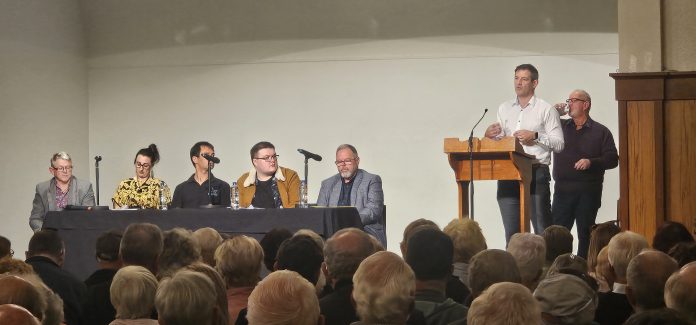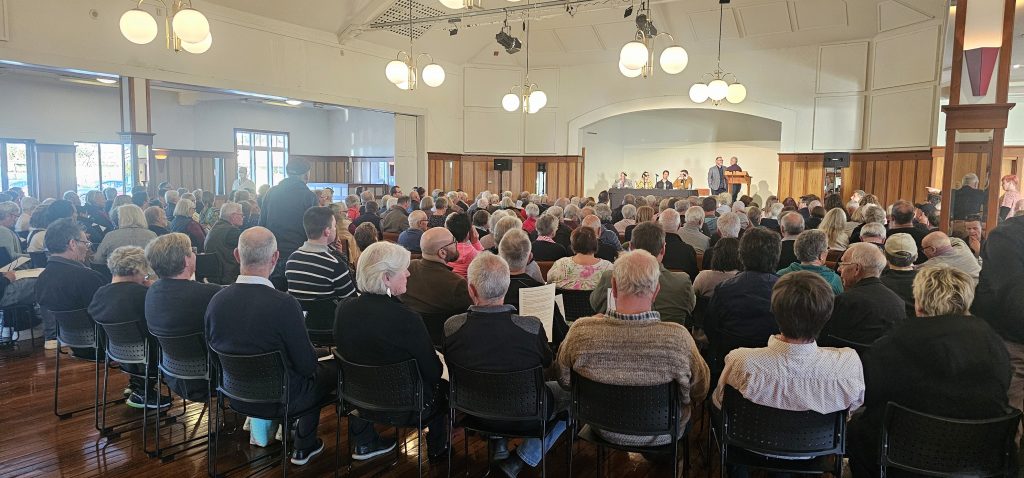
The Timaru public flocked to the Caroline Bay Hall in full force to attend a public meeting regarding the future of the town’s Theatre Royal building.
The topic has been hotly debated for the past several months after the Timaru District Council’s decision to move on from a proposed $57.1 million heritage hub.
South Canterbury Drama league board member Chris Thomas called the meeting to give the public a chance to have their voices heard.
The meeting, held on Monday at 5.30pm, began with chairman Murray Cleverly setting the ground rules for the meeting’s proceedings, encouraging the nearly 400 attendees to be ‘‘part of the solution and not part of the problem’’.
Speaking first as part of a ‘‘sector specialist’’ panel was Save Timaru’s Arts and Rebuild out Theatre co-founder Jess Young.
She discussed the wider importance a theatre brought to the community.
‘‘A theatre is not a nice-to-have, it is an essential facility that is absolutely vital in futureproofing our district from becoming a dull, derelict ghost town devoid of art and culture.’’
Next was Ethan Richardson, who emphasised the importance of leaning into Timaru’s heritage buildings from an economic and tourism perspective.
‘‘We must seize upon the opportunity to have a high-value tourist economy — to do that we need an x-factor, something special, something no-one else has.’’
South Canterbury Museum Development Trust chairman John Simpson then spoke to the museum side of the proposed heritage hub.
He highlighted the important part the museum played in the community and emphasised the need for a new museum space as its current location was no longer fit-for-purpose.
Vibrant NZ owner Tristan King spoke next and said he believed the $57.1m heritage hub project was the best option on the table — and the best option there ever would be.
He also questioned the decision of a combined library and theatre site when it came to the obvious sound needs of the facilities.
Mr Thomas was the final panel speaker, and said Timaru was ‘‘a town that’s had the heart closed down’’.
He also elaborated on his ‘‘myth-busting’’ sheet, which had been handed out to all those in attendance.

The panel collectively spoke for 30 minutes; the floor was then opened up for those present to ask questions for the panel to answer.
Over the course of the next hour many members of the public took the chance to ask questions which included: the cost to run the theatre, why those who want a theatre can not fundraise, the possibility to build a new theatre like Ashburton, literacy vs sport, would there be a peer assessment of the original plan and should there be a focus on individual and not hub projects.
Many of Timaru’s elected district councillors were there for the meeting and once questions had concluded, chief executive Nigel Trainor took to the stage to address some of the questions.
Mr Trainor said the council was resolved to look at further options, and they were getting the plan peer-reviewed.
He said the hope was to bring costs down, and operating costs were an important consideration.
Timaru mayor Nigel Bowen then spoke.
Mr Bowen assured those at the meeting that the council was invested in a solution and that they were working as fast as they could to bring about that solution.
He also said a plan would be brought forward for public consultation in October.
Mr Thomas then closed the meeting by putting forward some marching orders for the future.
He encouraged people to take their own actions, write to councillors, attend future council meetings and work together on how to get the project over the line.
His handout included a QR code that led to a survey which he encouraged everyone to fill out.
The meeting concluded just short of two hours.




